2005 AUDI A6 navigation
[x] Cancel search: navigationPage 75 of 92
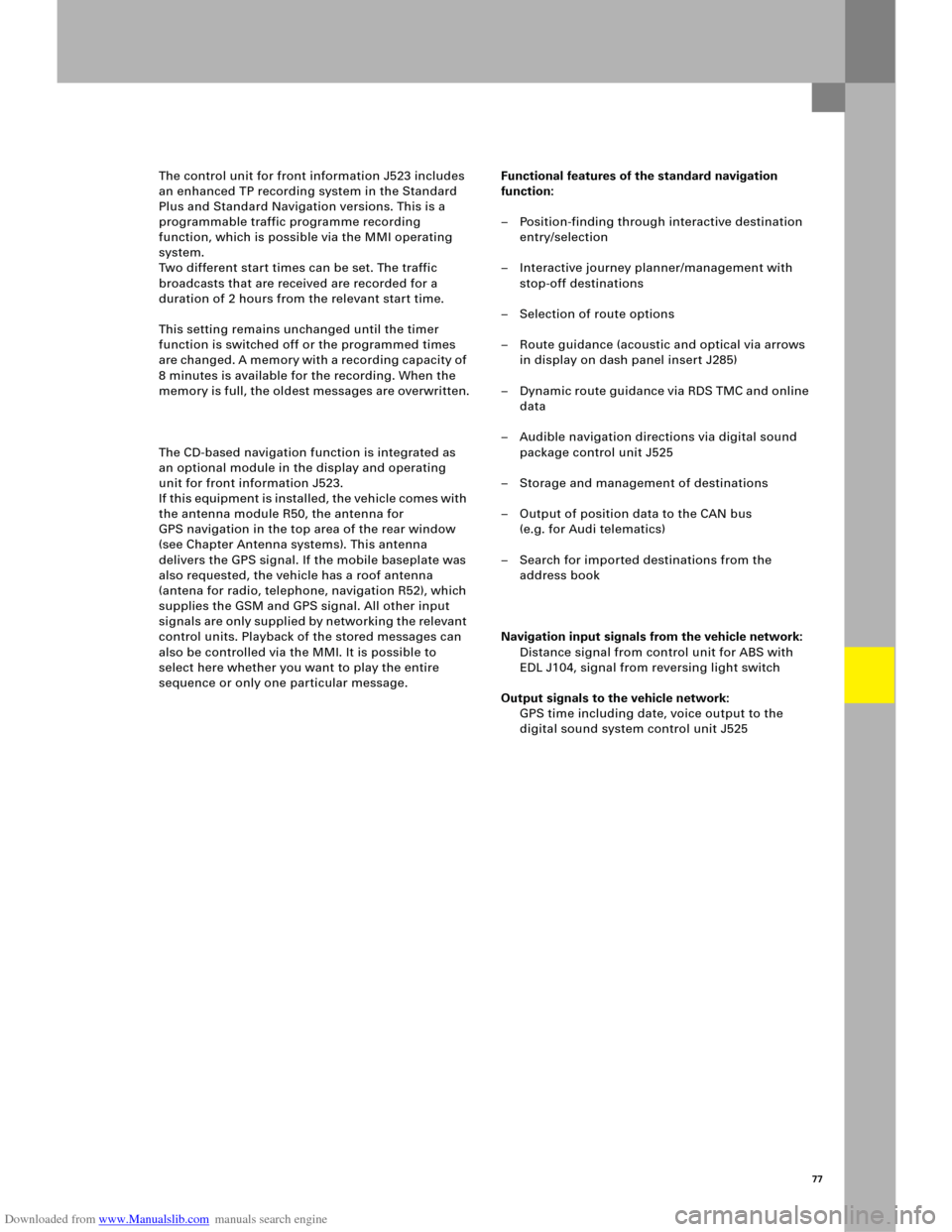
Downloaded from www.Manualslib.com manuals search engine 77
The control unit for front information J523 includes
an enhanced TP recording system in the Standard
Plus and Standard Navigation versions. This is a
programmable traffic programme recording
function, which is possible via the MMI operating
system.
Two different start times can be set. The traffic
broadcasts that are received are recorded for a
duration of 2 hours from the relevant start time.
This setting remains unchanged until the timer
function is switched off or the programmed times
are changed. A memory with a recording capacity of
8 minutes is available for the recording. When the
memory is full, the oldest messages are overwritten.
The CD-based navigation function is integrated as
an optional module in the display and operating
unit for front information J523.
If this equipment is installed, the vehicle comes with
the antenna module R50, the antenna for
GPS navigation in the top area of the rear window
(see Chapter Antenna systems). This antenna
delivers the GPS signal. If the mobile baseplate was
also requested, the vehicle has a roof antenna
(antena for radio, telephone, navigation R52), which
supplies the GSM and GPS signal. All other input
signals are only supplied by networking the relevant
control units. Playback of the stored messages can
also be controlled via the MMI. It is possible to
select here whether you want to play the entire
sequence or only one particular message.Functional features of the standard navigation
function:
– Position-finding through interactive destination
entry/selection
– Interactive journey planner/management with
stop-off destinations
– Selection of route options
– Route guidance (acoustic and optical via arrows
in display on dash panel insert J285)
– Dynamic route guidance via RDS TMC and online
data
– Audible navigation directions via digital sound
package control unit J525
– Storage and management of destinations
– Output of position data to the CAN bus
(e.g. for Audi telematics)
– Search for imported destinations from the
address book
Navigation input signals from the vehicle network:
Distance signal from control unit for ABS with
EDL J104, signal from reversing light switch
Output signals to the vehicle network:
GPS time including date, voice output to the
digital sound system control unit J525
Page 76 of 92
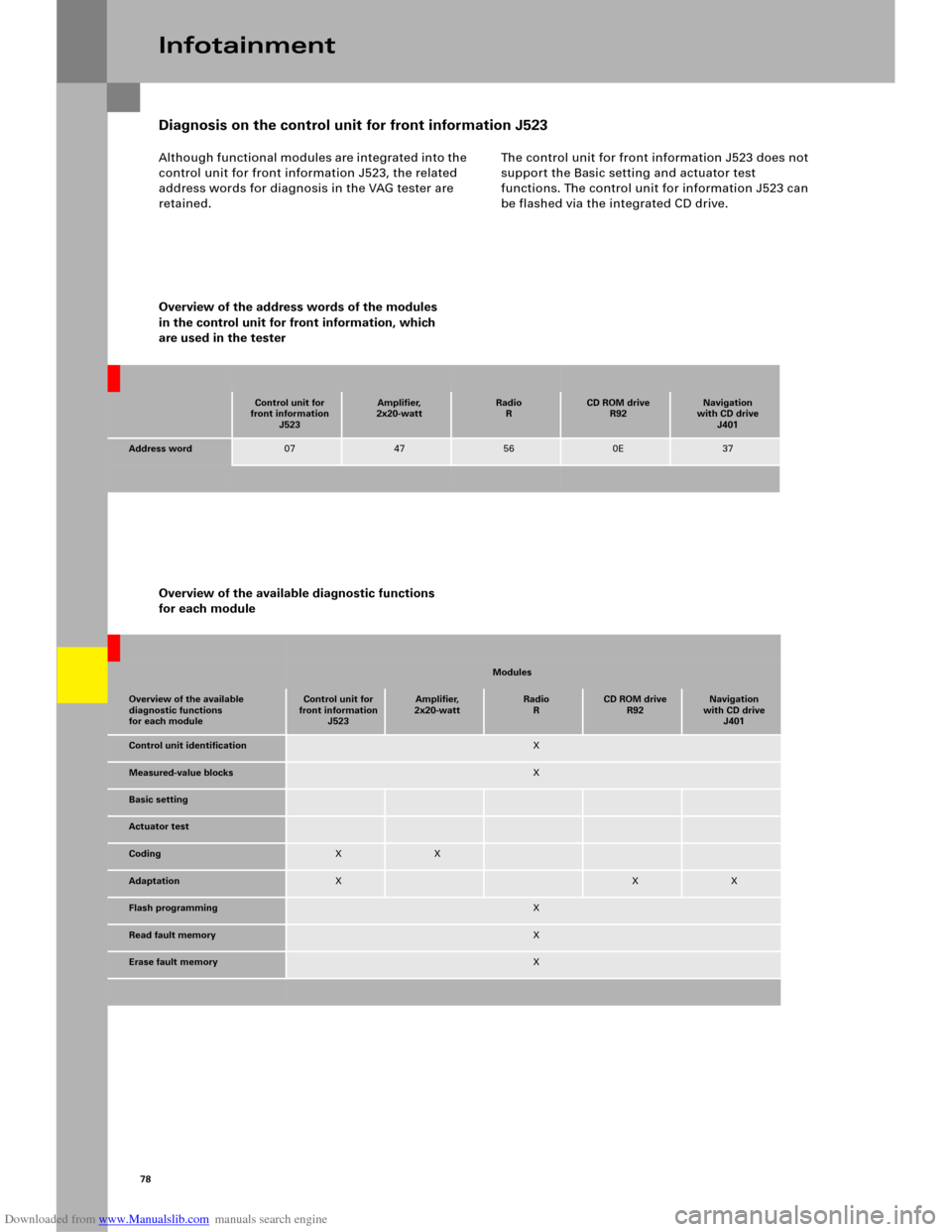
Downloaded from www.Manualslib.com manuals search engine 78
Although functional modules are integrated into the
control unit for front information J523, the related
address words for diagnosis in the VAG tester are
retained.The control unit for front information J523 does not
support the Basic setting and actuator test
functions. The control unit for information J523 can
be flashed via the integrated CD drive.
Infotainment
Modules
Overview of the available
diagnostic functions
for each moduleControl unit for
front information
J523Amplifier,
2x20-wattRadio
RCD ROM drive
R92Navigation
with CD drive
J401
Control unit identificationX
Measured-value blocksX
Basic setting
Actuator test
CodingXX
AdaptationXXX
Flash programmingX
Read fault memoryX
Erase fault memoryX
Overview of the available diagnostic functions
for each module Overview of the address words of the modules
in the control unit for front information, which
are used in the tester
Control unit for
front information
J523Amplifier,
2x20-wattRadio
RCD ROM drive
R92Navigation
with CD drive
J401
Address word0747560E37
Diagnosis on the control unit for front information J523
Page 77 of 92
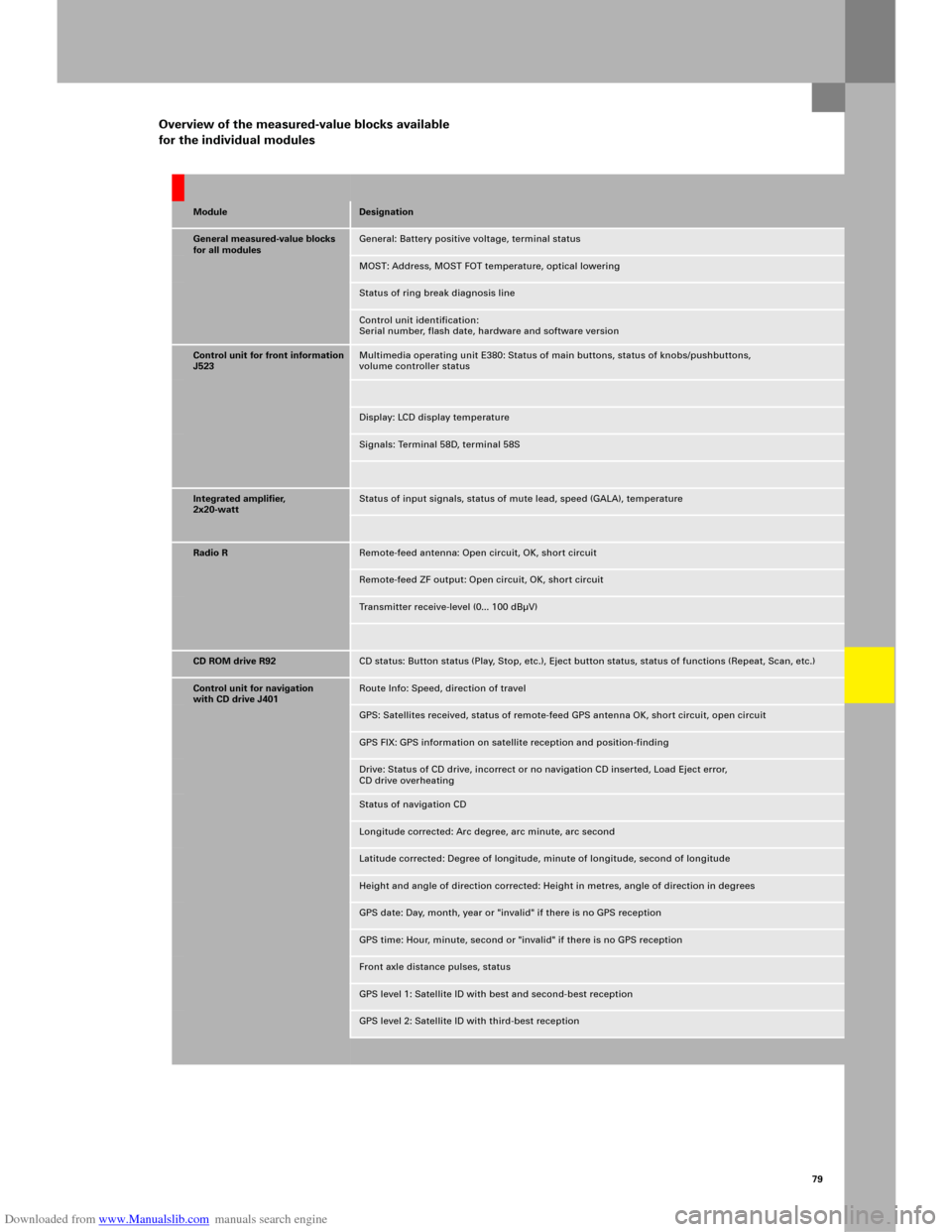
Downloaded from www.Manualslib.com manuals search engine 79
Overview of the measured-value blocks available
for the individual modules
ModuleDesignation
General measured-value blocks
for all modulesGeneral: Battery positive voltage, terminal status
MOST: Address, MOST FOT temperature, optical lowering
Status of ring break diagnosis line
Control unit identification:
Serial number, flash date, hardware and software version
Control unit for front information
J523Multimedia operating unit E380: Status of main buttons, status of knobs/pushbuttons,
volume controller status
Display: LCD display temperature
Signals: Terminal 58D, terminal 58S
Integrated amplifier,
2x20-wattStatus of input signals, status of mute lead, speed (GALA), temperature
Radio RRemote-feed antenna: Open circuit, OK, short circuit
Remote-feed ZF output: Open circuit, OK, short circuit
Transmitter receive-level (0... 100 dBµV)
CD ROM drive R92CD status: Button status (Play, Stop, etc.), Eject button status, status of functions (Repeat, Scan, etc.)
Control unit for navigation
with CD drive J401Route Info: Speed, direction of travel
GPS: Satellites received, status of remote-feed GPS antenna OK, short circuit, open circuit
GPS FIX: GPS information on satellite reception and position-finding
Drive: Status of CD drive, incorrect or no navigation CD inserted, Load Eject error,
CD drive overheating
Status of navigation CD
Longitude corrected: Arc degree, arc minute, arc second
Latitude corrected: Degree of longitude, minute of longitude, second of longitude
Height and angle of direction corrected: Height in metres, angle of direction in degrees
GPS date: Day, month, year or "invalid" if there is no GPS reception
GPS time: Hour, minute, second or "invalid" if there is no GPS reception
Front axle distance pulses, status
GPS level 1: Satellite ID with best and second-best reception
GPS level 2: Satellite ID with third-best reception
Page 78 of 92
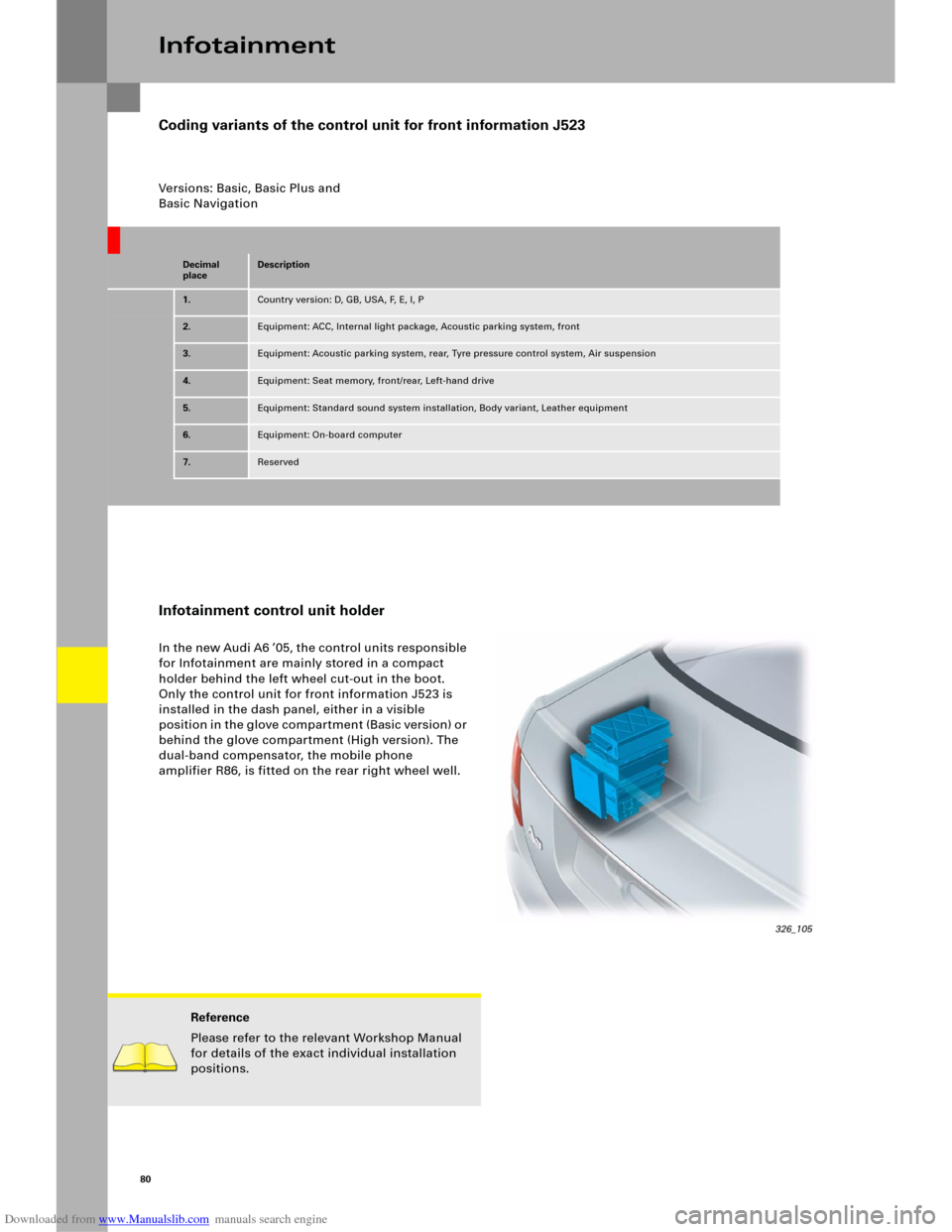
Downloaded from www.Manualslib.com manuals search engine 80
Versions: Basic, Basic Plus and
Basic Navigation
Infotainment
Decimal
placeDescription
1.Country version: D, GB, USA, F, E, I, P
2.Equipment: ACC, Internal light package, Acoustic parking system, front
3.Equipment: Acoustic parking system, rear, Tyre pressure control system, Air suspension
4.Equipment: Seat memory, front/rear, Left-hand drive
5.Equipment: Standard sound system installation, Body variant, Leather equipment
6.Equipment: On-board computer
7.Reserved
Infotainment control unit holder
In the new Audi A6 ’05, the control units responsible
for Infotainment are mainly stored in a compact
holder behind the left wheel cut-out in the boot.
Only the control unit for front information J523 is
installed in the dash panel, either in a visible
position in the glove compartment (Basic version) or
behind the glove compartment (High version). The
dual-band compensator, the mobile phone
amplifier R86, is fitted on the rear right wheel well.
Reference
Please refer to the relevant Workshop Manual
for details of the exact individual installation
positions.
Coding variants of the control unit for front information J523
326_105
Page 84 of 92
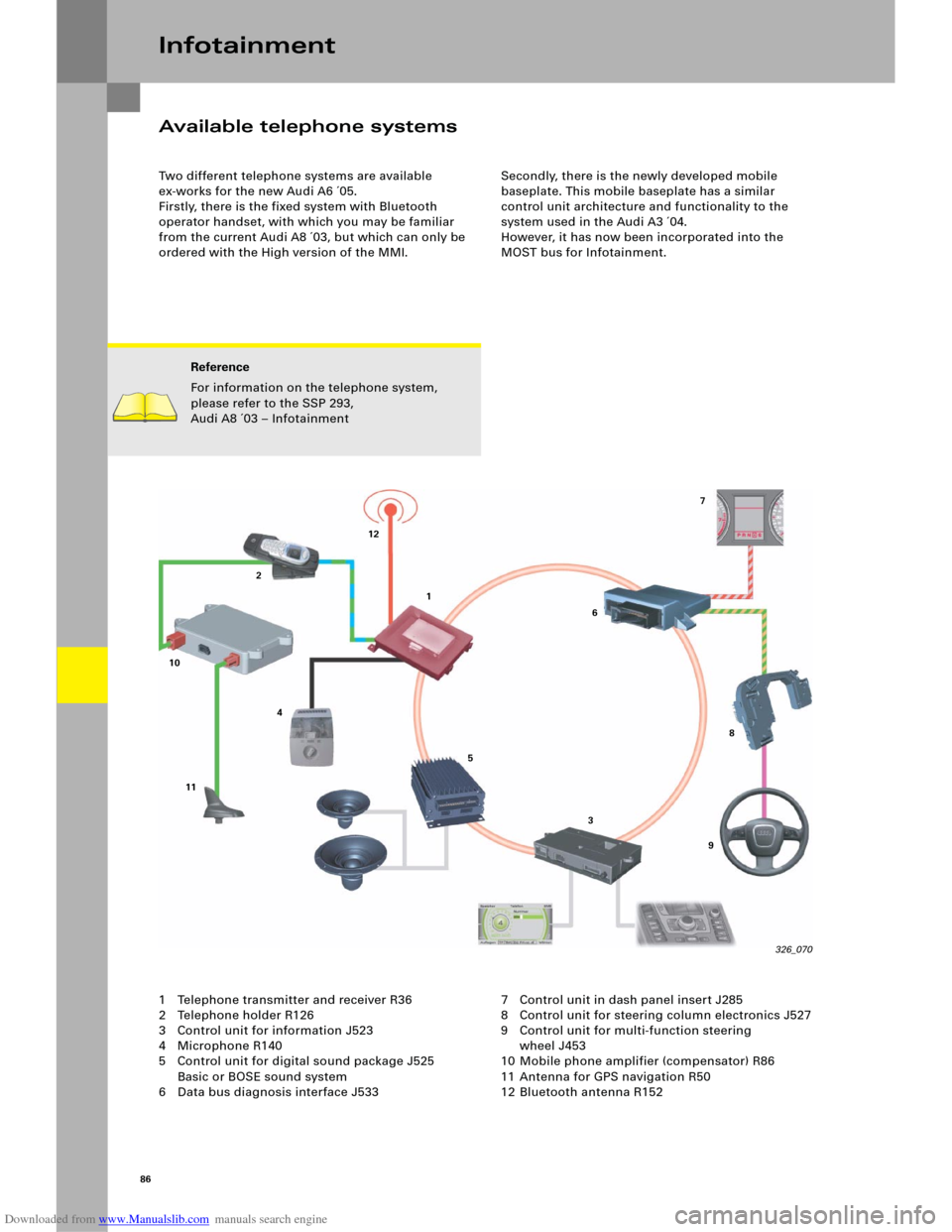
Downloaded from www.Manualslib.com manuals search engine 86
Available telephone systems
Two different telephone systems are available
ex-works for the new Audi A6 ´05.
Firstly, there is the fixed system with Bluetooth
operator handset, with which you may be familiar
from the current Audi A8 ´03, but which can only be
ordered with the High version of the MMI. Secondly, there is the newly developed mobile
baseplate. This mobile baseplate has a similar
control unit architecture and functionality to the
system used in the Audi A3 ´04.
However, it has now been incorporated into the
MOST bus for Infotainment.
Infotainment
1 Telephone transmitter and receiver R36
2 Telephone holder R126
3 Control unit for information J523
4 Microphone R140
5 Control unit for digital sound package J525
Basic or BOSE sound system
6 Data bus diagnosis interface J533 7 Control unit in dash panel insert J285
8 Control unit for steering column electronics J527
9 Control unit for multi-function steering
wheel J453
10 Mobile phone amplifier (compensator) R86
11 Antenna for GPS navigation R50
12 Bluetooth antenna R152
Reference
For information on the telephone system,
please refer to the SSP 293,
Audi A8 ´03 – Infotainment
326_070 11 10212
41
5
367
8
9
Page 85 of 92
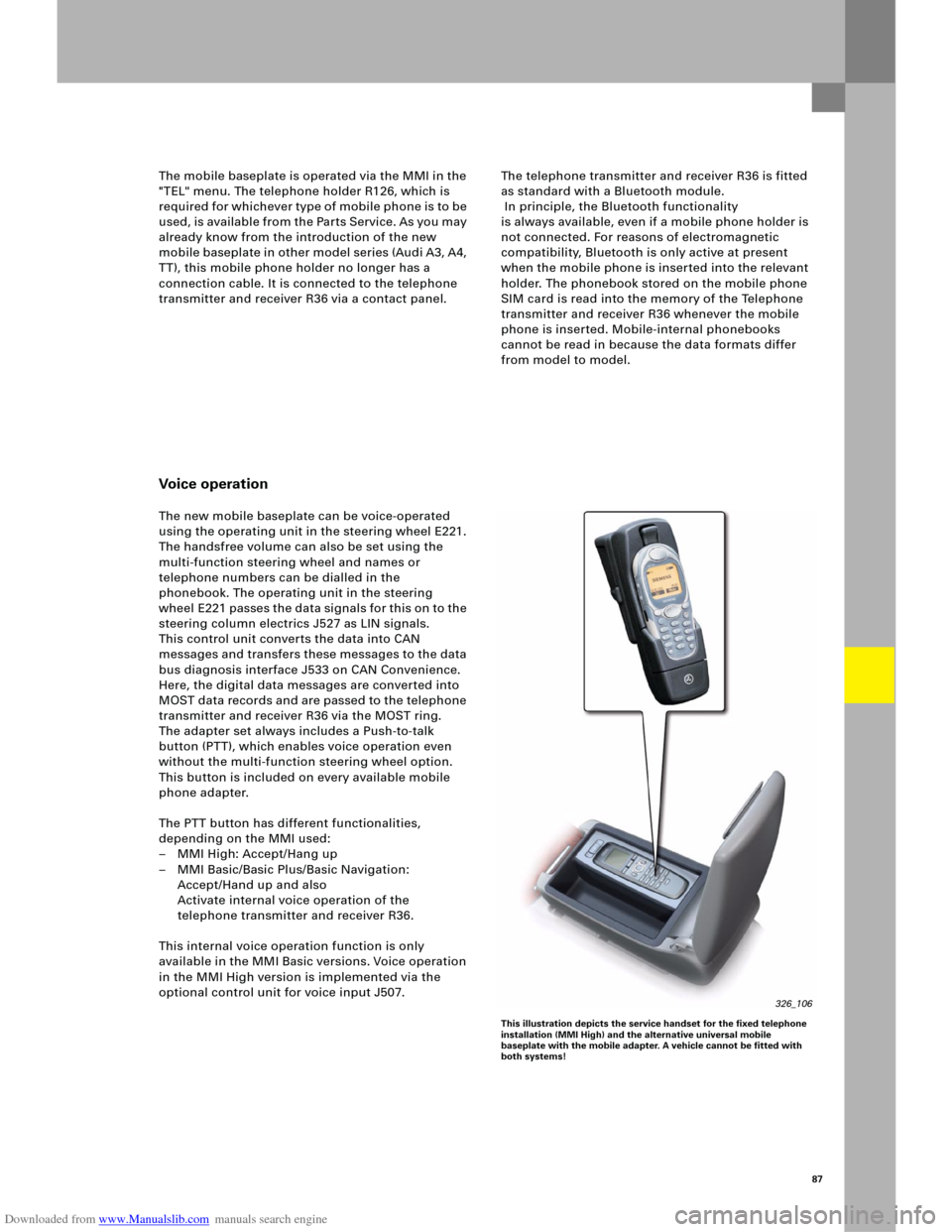
Downloaded from www.Manualslib.com manuals search engine 87
The telephone transmitter and receiver R36 is fitted
as standard with a Bluetooth module.
In principle, the Bluetooth functionality
is always available, even if a mobile phone holder is
not connected. For reasons of electromagnetic
compatibility, Bluetooth is only active at present
when the mobile phone is inserted into the relevant
holder. The phonebook stored on the mobile phone
SIM card is read into the memory of the Telephone
transmitter and receiver R36 whenever the mobile
phone is inserted. Mobile-internal phonebooks
cannot be read in because the data formats differ
from model to model. The mobile baseplate is operated via the MMI in the
"TEL" menu. The telephone holder R126, which is
required for whichever type of mobile phone is to be
used, is available from the Parts Service. As you may
already know from the introduction of the new
mobile baseplate in other model series (Audi A3, A4,
TT), this mobile phone holder no longer has a
connection cable. It is connected to the telephone
transmitter and receiver R36 via a contact panel.
Voice operation
The new mobile baseplate can be voice-operated
using the operating unit in the steering wheel E221.
The handsfree volume can also be set using the
multi-function steering wheel and names or
telephone numbers can be dialled in the
phonebook. The operating unit in the steering
wheel E22 1 passes the data si gnals fo r this on to the
steering column electrics J527 as LIN signals.
This control unit converts the data into CAN
messages and transfers these messages to the data
bus diagnosis interface J533 on CAN Convenience.
Here, the digital data messages are converted into
MOST data records and are passed to the telephone
transmitter and receiver R36 via the MOST ring.
The adapter set always includes a Push-to-talk
button (PTT), which enables voice operation even
without the multi-function steering wheel option.
This button is included on every available mobile
phone adapter.
The PTT button has different functionalities,
depending on the MMI used:
– MMI High: Accept/Hang up
– MMI Basic/Basic Plus/Basic Navigation:
Accept/Hand up and also
Activate internal voice operation of the
telephone transmitter and receiver R36.
This internal voice operation function is only
available in the MMI Basic versions. Voice operation
in the MMI High version is implemented via the
optional control unit for voice input J507.
326_106
This illustration depicts the service handset for the fixed telephone
installation (MMI High) and the alternative universal mobile
baseplate with the mobile adapter. A vehicle cannot be fitted with
both systems!
Page 86 of 92
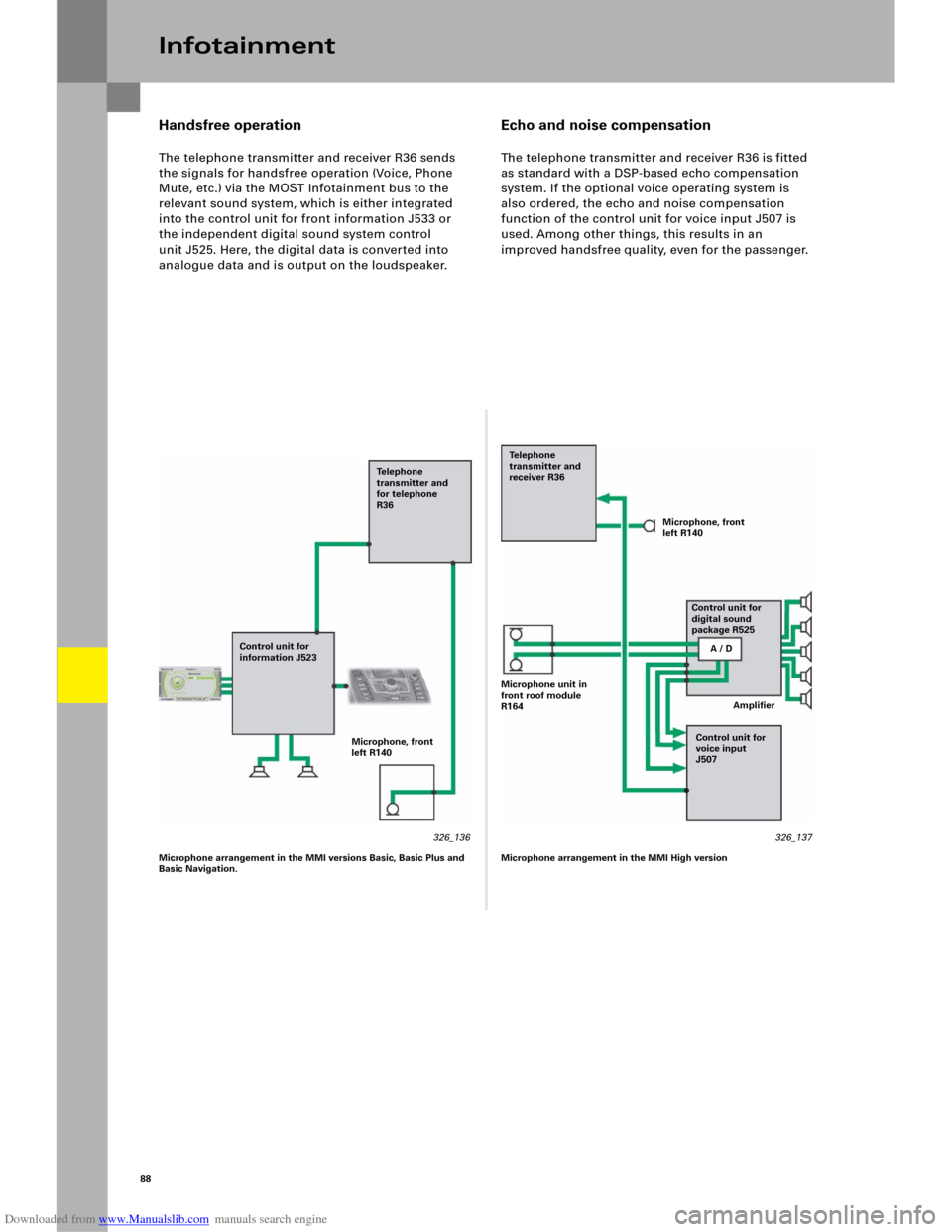
Downloaded from www.Manualslib.com manuals search engine 88
Handsfree operation
The telephone transmitter and receiver R36 sends
the signals for handsfree operation (Voice, Phone
Mute, etc.) via the MOST Infotainment bus to the
relevant sound system, which is either integrated
into the control unit for front information J533 or
the independent digital sound system control
unit J525. Here, the digital data is converted into
analogue data and is output on the loudspeaker.
Echo and noise compensation
The telephone transmitter and receiver R36 is fitted
as standard with a DSP-based echo compensation
system. If the optional voice operating system is
also ordered, the echo and noise compensation
function of the control unit for voice input J507 is
used. Among other things, this results in an
improved handsfree quality, even for the passenger.
Infotainment
Microphone arrangement in the MMI High version Microphone arrangement in the MMI versions Basic, Basic Plus and
Basic Navigation.
Microphone, front
left R140 Control unit for
information J523Te l e p h o n e
transmitter and
for telephone
R36
326_136
Microphone unit in
front roof module
R164Microphone, front
left R140
A / D
Amplifier Control unit for
digital sound
package R525 Te l e p h o n e
transmitter and
receiver R36
326_137 Control unit for
voice input
J507